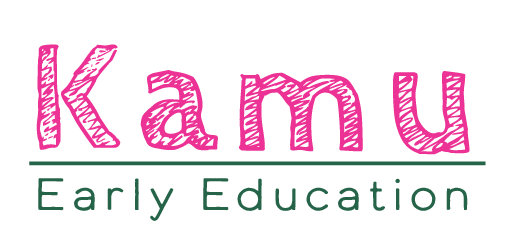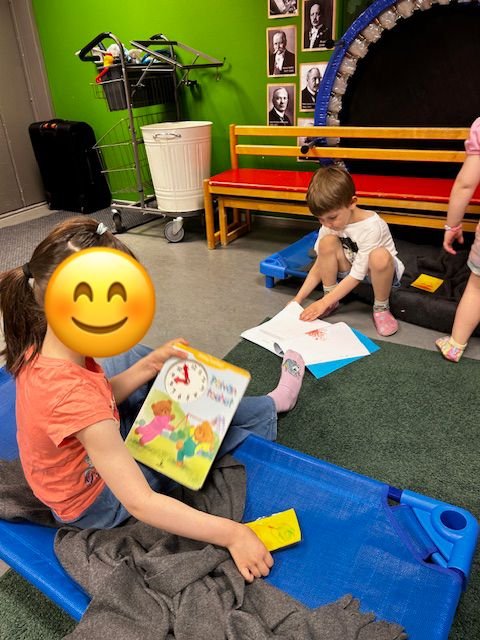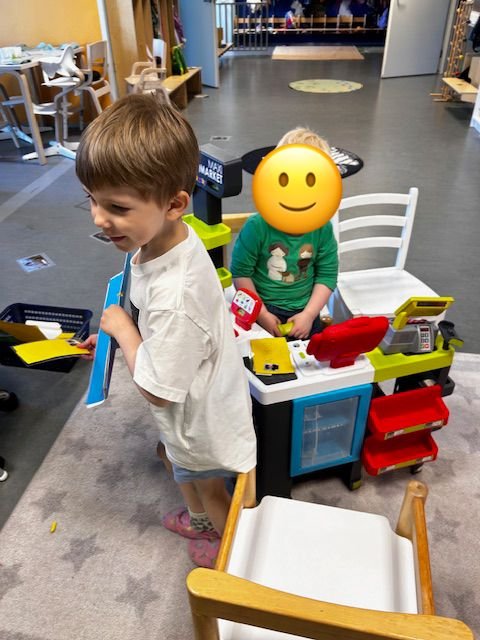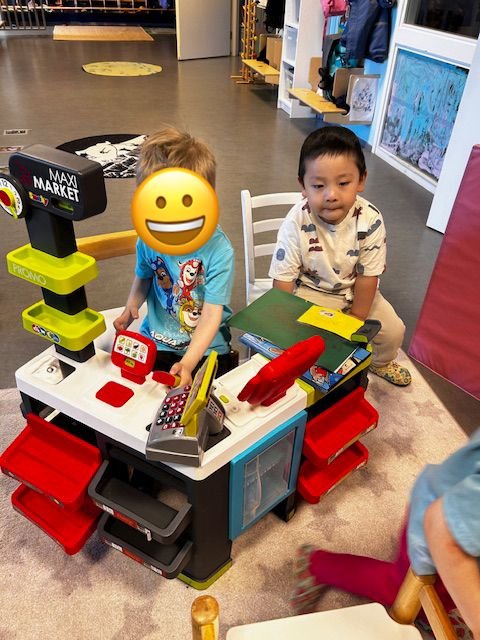Kamukoti's Book Project
We created a library with our kids! The children in Kamukoti have shown a lot of interest in books: looking at the pictures in different kinds of books, having adults read to them, and sharing books with their friends. It’s wonderful to see the children so excited about something, so we wanted to encourage their new interest and started a book project. Each child would make their own book: creating a cover, making the inside pages with pictures/stories, and then bind the book together. This project started with the Caterpillars group (Toukat): 1-2.5 years old. They were constantly taking new books from the bookshelf to read, reading to each other, and wanting adults to read to them repeatedly. When sharing our idea with other staff, they were also excited about the project and began to plan their own books with their groups, (Pinecones (Kävyt): 1.5-3 yrs., Ladybugs (Leppikset): 3-5 yrs., and we made it a whole kindergarten project! Every group of different ages would make their own books.
When creating a new project, it’s important to think about the skill level for their age range. In the Caterpillars group we have children that range from 1-2.5 years old. We wanted to develop their creativity so we decided that each page would be a different form of artwork. This will help them to develop different skills and learn how to use different tools.
The Caterpillars practiced holding crayons in a three-finger grasp.
For our very first page we painted using watercolor paints, teaching them how they dip their brush into water first, then the color they want, and finally onto the page. These instructions can be difficult for children at this age. It teaches them to learn to follow simple instructions, use hand-eye coordination, and to help them develop their grip while holding a paintbrush. We listened to classical music while painting which also helps children to appreciate different kinds of music and culture.
For another page we used wood glue, glue sticks, and different colored silk paper. We placed the wood glue on a small paper plate which is easy for the children to take the glue from, and gave them glue sticks, showing the group how they should spread glue over the page. Once this was done, precut squares were placed next to them so they could independently choose the colors they wanted to stick down onto the page. They could put as much or as little silk paper as they wanted to. Our group really enjoys making arts and crafts, so much so that many didn’t want to stop.
For another page the children were given crayons and asked to draw whatever picture they wanted onto the page. This helps them to practice holding a crayon with a three-finger grip and learn how to put pressure onto the crayon to get a darker color. All these skills are important for young children to develop.
We documented the children making each page, taking pictures while creating the artwork. Afterwards we printed up a couple pictures of each child while they were working on the page, and they became another page in their book. First the page of their painting or artwork and next the pictures of them making it. Every page was laminated so the book would survive even if it was put into a child’s mouth and would hopefully last throughout the years to be enjoyed again and again. It’s especially fun for children of a young age to be able to see themself in a book!
Finally, a picture was taken of each child and placed onto colorful card paper with the title proclaiming, “Ville’s Book!” We used a hole puncher to create holes on every page and the book was bound together with string.
Since the Caterpillars children are so young, some not even able to speak yet, we wanted to create a book that they can enjoy now, that didn’t need any words to be read. A book that they could read to themselves and remember back on, even as they get older. It started off as a simple idea but became a very treasured project that inspired other teachers in different groups to make their own book projects with their kids.
For the Pinecone group, their book idea was more focused on animals. Each child chose their own favorite animal (e.g. a cat, a bear, a tiger, a rabbit, a hedgehog, etc.). Each page of the book was a special representation of that animal. On one page, the children were asked “what feelings does a bear make you feel?” (e.g. joy, happiness, sadness, fear, etc.) and then they used corresponding watercolors to paint that feeling onto the page. A joyful feeling- light, bright colors like yellow, orange, pink. A sad feeling- dark blue, grey and black. A happy feeling- light green, blue, and light red. The Pinecones teachers printed out the footprints of each animal; the children then glued the footprints onto the page as if the animal had walked across it. It was fun for them to compare the different footprint shapes and sizes.
For the final page, they were asked general questions about their animal like: What does this animal eat? Where does it live? How long does it live for? What color is it? Does it like cold or hot weather? Does it like to swim? What sounds does the animal make? The child’s answer to the question was first written down and then the correct answer was written next to it so they could compare. Of course, the answers the children gave were very amusing. Overall, a lot of fun for everyone!
The Ladybug group, for example, made their own books, also using different skills and techniques for every page. They discussed with the group about how a book has a cover and a pack page. As every book has a name, they asked the children to think of a name for their book. Once they had a name, they were asked to draw of picture that represented the name they came up with. For example, one child named their book “Äiti hississä” (Mom in the elevator), so the child was asked to draw a picture of their mother in an elevator. The group then told a story about their cover page picture which was transcribed and placed into the book as one page. For another page, they used watercolors to paint their family, their grandparents, parents, and siblings. Since they are older and have the language skills to communicate, they told stories about the family picture that they painted which was transcribed by a teacher. That story was printed up and added to their book.
Some of the children in the group are already able to read, so a book like this is exciting for them; they can read their own story that they created! The ideas are endless when doing a project like this with many different ages. Simple or more complex, long story form or large pictures with simple text, this project is something that will awaken children’s imagination, to create something that they can hold in their hands and enjoy for years.
As nature is an important part of our pedagogy, the Ladybug group decided to include nature in the last part of their book. During a forest trip, the children were instructed to collect three items from the forest floor (sticks, leaves, pinecones, etc.). Once they had found them, they glued the items down onto their page using wood glue. Looking at the items that they collected, they then came up with a story about them that was typed up and added to their book. This encourages the children to use their creativity and imagination to come up with a fun story.
As part of the project, the Ladybug group made their own library, using materials found in the kindergarten like mats and chairs, cushions and toys. They built the library using their own ideas about how to build it, and then we rented books from the library using library cards they had made themselves and read the books they created. The children listened to stories written by their friends and shared their artwork with each other. We played calming music and whispered as you do in a library. It was so enjoyable!
Our book project was a wonderful project and something that the children can look back on, time and time again. This kind of project can be done again, using different methods to make the pages, getting more complex as the children grow and develop. Hopefully they will treasure the books for many years and look back on them fondly.












































